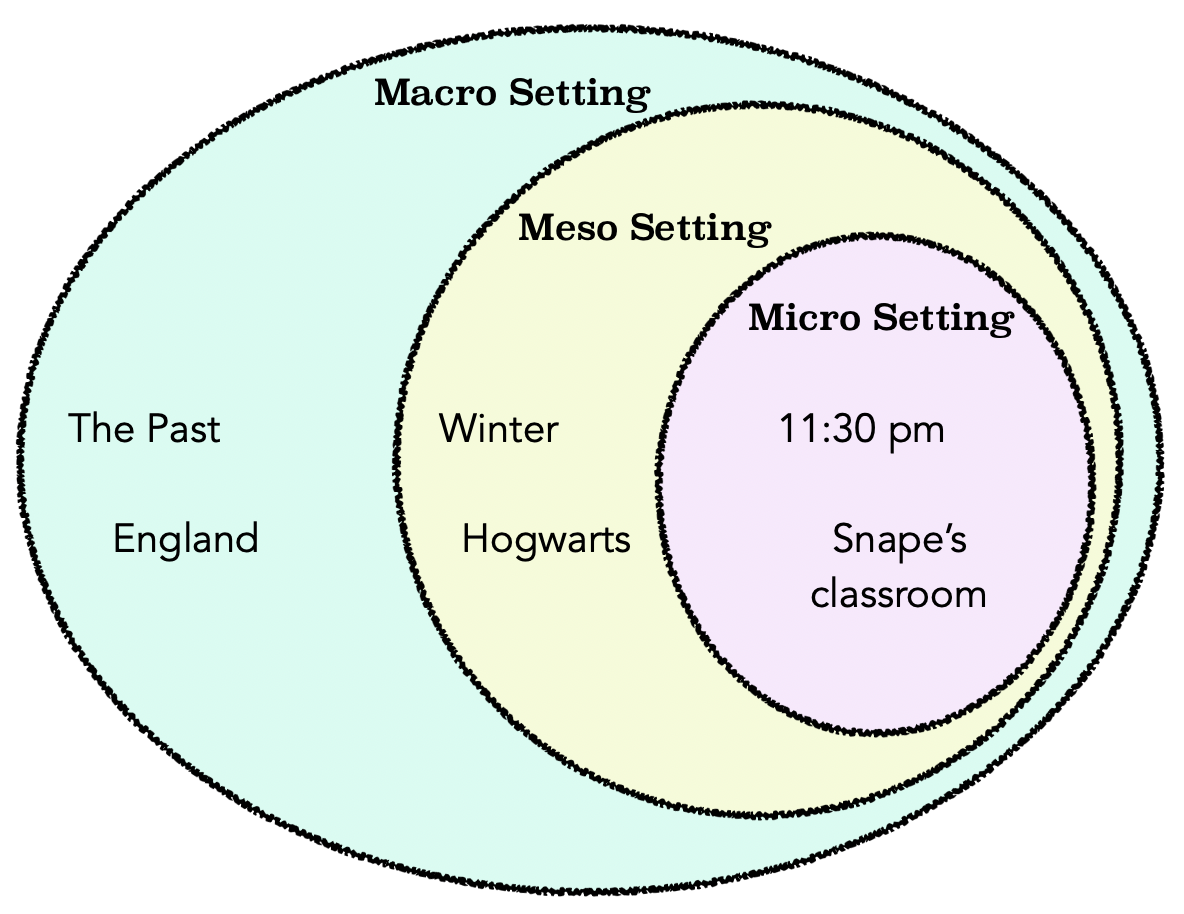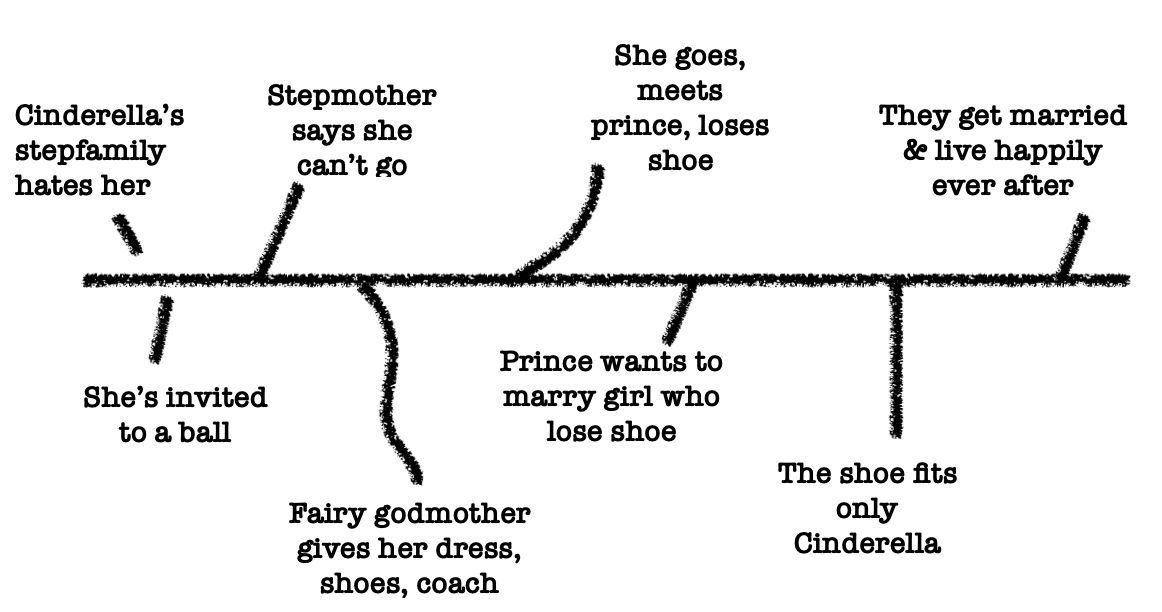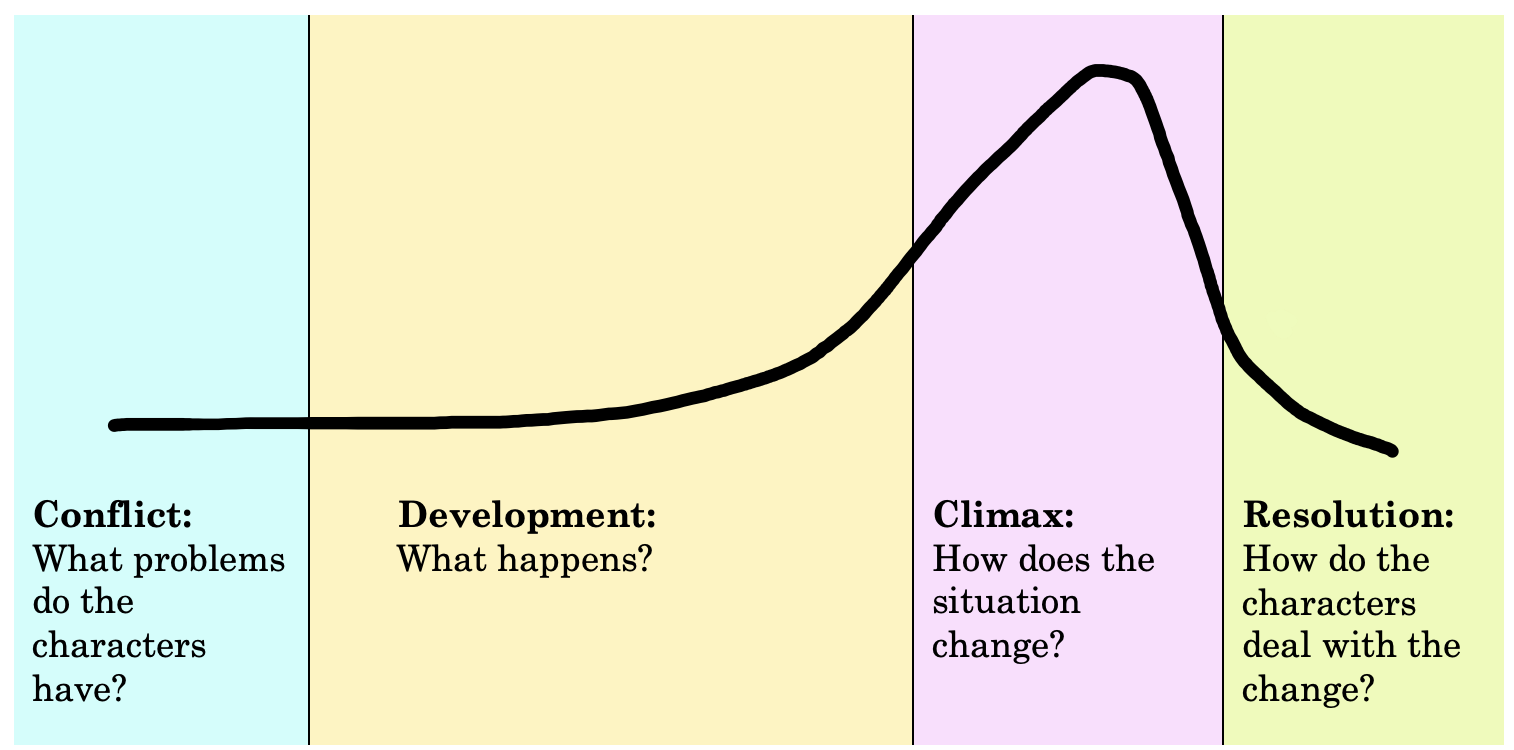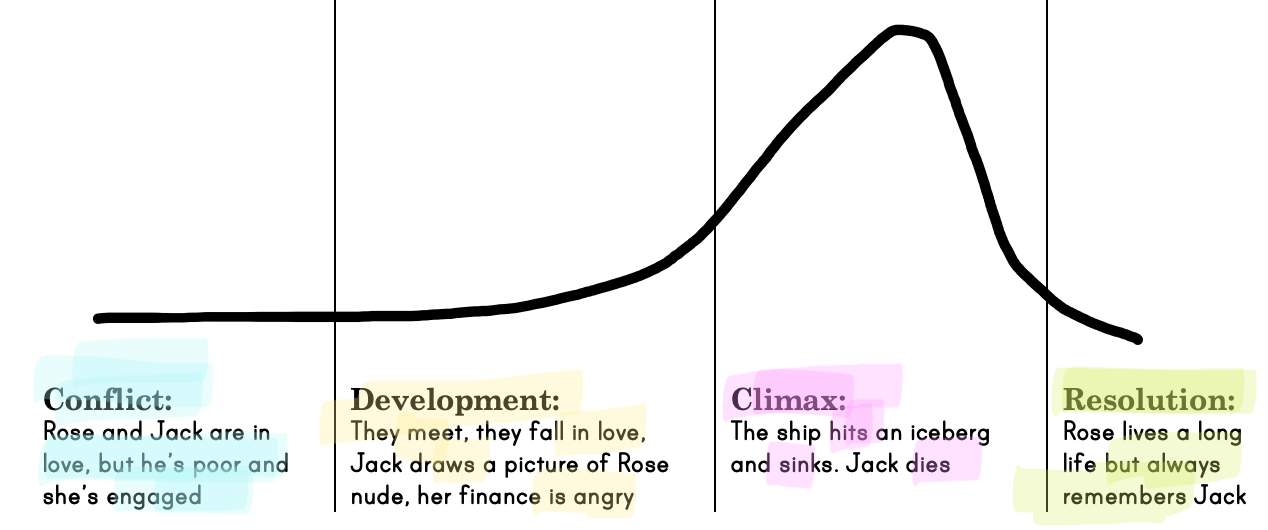1 Vocabulary for Discussing Fiction
Learning Objectives
1. Setting
- Define “setting”
- Recognize or classify settings as “micro, meso, macro”
- Read a narrative and identify the setting
2. Character
- Define “character”
- Explain the difference between a main and minor character
- Name three types of characters
3. Plot
- Define “plot”
- Use a timeline to summarize the plot of a narrative
- Use a narrative arc to analyze the plot of a narrative
- Divide a narrative arc into four sections correctly
- Define conflict, development, climax, resolution
- Name the three major types of conflict
4. Literary Terms
- Define the words fiction, non-fiction, biography, autobiography, memoir, exposition, narrative, essay, myth, folk tale, novel, graphic novel
- Name four traditional story forms
- Understand the differences between traditional story forms
5. Using the Chapter Exercises
- Define “literature circle”
- Give three or more examples of roles in a literature circle
1. Setting
“Setting” is the time and the place of the story. When and where does it happen? The answer to those questions is the setting.
Try It: Identify the settings of each story.
Setting in More Detail
There are three levels we can consider when discussing setting
- the smallest and most specific level: the micro setting
- the medium level, or the meso setting: in between the smallest and largest levels
- the most general, or the macro setting
This example gives the detailed setting for a story that most people know — Harry Potter. Notice that the setting always includes both the time and the place!

Fig 1. Example of detailed setting for a scene from Harry Potter
For most fiction, the macro setting does not change. The micro setting changes when the characters move around or time goes on.
Try It: Here are some times and places (not from any specific story). Try to match them to the correct level of detail.
Try It: These times and places are from the story “Cinderella.” Match them to the correct level of detail. Try to remember at least two different micro settings of the story.
2. Characters
“Characters” are the people – or non-human elements – that participate in a narrative.
What are the “characters” in this list? Choose as many answers as you think are correct.
A character in work of fiction can be a main character or minor character.
Main characters make the story happen. The story might be told from their point of view. They are the ones the author spends most time describing. They are the ones whose actions affect the story. It’s common to see these three main character types:
- a protagonist, also called the “hero” or “good guy”
- the protagonist’s friend, sidekick or loved one
- the antagonist, also called the “villain” or “bad guy”
Try It: For each of these works of fiction, list the main characters. If the answer isn’t a main character, leave it in the box.
Think About …
Can an animal be a character?
What’s the difference between a main character and a minor character?
3. Plot
Imagine that someone asks you to tell them the story of a movie you saw. You’ll tell them what happened, in the same time order as the movie showed you. In other words: You’ll tell them the plot.
A summary of a story is often just a summary of the plot.
One way to summarize a plot is by making a timeline to organize what happened first, second, third … This is the timeline method. It puts the story into chronological order.

Another way to understand the plot is to ask, “What basic problems do the characters have? How do these problems make the story happen?” This is the narrative arc method.

A Narrative Arc is a curved line with 4 sections. Every work of fiction – and every good “story” – has all 4 sections. The line (the “arc”) rises to show how active or exciting the story is.
A narrative arc, like a timeline, includes a summary of the most important key events, but a narrative arc also includes a statement of the conflict.
Try It: Fill out the narrative arc for the stories we’ve been talking about. The first is done as an example.
1. Example: Titanic

2. “Cinderella”
3. Harry Potter
You notice that the “Conflict” is a simple statement of the two sides that oppose each other. There are three basic types of conflict.
- Person vs. Self
A person’s problem is within themself. - Person vs. Person
Two characters disagree with each other, which causes problems. - Person vs. Environment
There are many possible meanings of “environment” here. It might mean a group of people; it might mean the natural environment; it might mean society or laws.
Notice that these first three concepts (setting, character, plot) answer the key questions“Where? When? Who? What? Why?”
4. Literary Terms
Check your understanding and learn these words.
Note: When we speak about writing types, we can use the words text or reading for any type of writing.
More about Specific Types of Short Fiction
There are many varieties of short fiction. These short works can be considered “short stories” in some ways, but not in others. Each form has its own unique cultural role. Humans created each type to fulfill a certain cultural need, which shapes their forms. Here are five common types of traditional short fiction.
Myth
Myths are some of the oldest stories ever told. ancient humans, looking around the mysterious natural world, created stories to explain what they saw. Myths answer the questions: Where did we come from? Why do we exist? Who created this world? Why does the sun rise, the winter come, the rainbow appear?
Western culture is founded on Greek and Roman cultures. These two cultures shared many of the same stories, although the languages were different. These stories have many of the same characters. Most come from a large family of gods who walked on Earth and often interacted with humans. The mythology of Greece and of Rome influence Western culture even today.
Many myths have these qualities: They involve gods, humans with god-like qualities, half-human, half-animal monsters, or humans who transform into animals or plants. They are set in ancient times. They often explain natural phenomena, answering questions like “Why do we hear thunder?” or “What happens after we die?” Finally, a single myth is often part of a much larger set of stories about the same characters.
-
Make a list of some myths you know.
Fable
Like a parable, a fable is meant to teach a lesson. However, a fable’s lesson is always very clear, and is often part of the story itself. Fables often have speaking animals as characters. the last line of the fable usually shares the lesson, which is called the moral.
-
Make a list of some fables you know.
Folktale
Every human culture has countless folktales. These are the stories spoken aloud and shared from the time before technology was used for entertainment. Folktales are shared for amusement and pleasure, but they also share cultural values such as what makes a good wife or a bad wife, how power should be handled, and why people should be honest.
Unlike a fable, a typical folktale does not end with a specific moral. The characters of a folktale are often human. Sometimes the teller of a folktale includes qualities to make it more authentic, adding sentences like “This happened in my grandmother’s time” or by naming a specific town or part of a country.
There is no strong division between a folktale and a myth, but folktales are typically more informal, passed along by word of mouth and not written down. Unlike a myth, a folktale almost never has a god as a character, and the characters in one folktale usually do not appear in any other folktale. A special kind of folktale is the legend or tall tale. These folktales have characters with amazing, exaggerated qualities or abilities.
-
Make a list of some folktales you know.
Fairy Tale
Fairy tales are a special group of folktales which are often told to children. While a folktale might be extremely violent or scary, a fairytale typically focuses on more pleasant things, such as fairies, talking animals, and treasure. The plot of a fairy tale is almost always the same: a person faces a challenge, and if they are good, honest and kind, they are rewarded – with marriage if they are female and with wealth if they are male. Interestingly, many fairy tales told today include a stepmother as a villain, or “bad guy.”
Like a fable, a fairy tale usually has some sort of lesson, but the lesson is implied rather than direct. The first words of a fairy tale are usually “Once upon a time,” and the last words are usually “… And they lived happily ever after.”
-
Make a list of some fairy tales you know.
Storytelling Practice
Think of all the many, many stories that you know. Choose one that you like and tell it to a small group of classmates. You should speak for just a few minutes. Make notes on the stories you hear. Try to identify which category the story belongs to: myth, parable, fable, folktale, or fairy tale.
5. Using the Chapter Questions
There are several possible ways to use the chapter questions. Here are some suggestions.
1. Complete the exercises independently
You can work through some or all the exercises as homework or in class, working in small groups to discuss the answers. Write the answers on your own paper and submit as a homework assignment.
2. Discuss in a literature circle
A literature circle is a small group of readers who discuss their reading in depth. There are many possible ways to form a literature circle; usually, each participant in a lit circle has a different job. If you do work in a lit circle, then each participant can choose one or more of the Study Guide questions and work on them independently before getting together with other members of the circle. Some suggested roles for members of a lit circle are:
- Plot Expert: This person understands the conflict, development, climax and resolution. This person can write BOTH a timeline and a Narrative Arc for the story. They can explain these to their group.
- Character expert: This person defines who the major characters are and describes their characters. They choose adjectives and quotations to support their ideas. This person may want to bring a handout with pictures or drawings of the characters to support their ideas.
- Summarizer: This person creates a summary of the plot to share with the group. The Summary should be short but include all the most important points.
- Sentence Clarifier: This person is responsible for explaining some challenging quotations or words to the group. The teacher might assign some phrases, the group might choose some lines, or the clarifier might choose their own difficult parts. They should be able to explain the difficult sections until everyone in the group understands them.
- Context Expert: This person goes beyond the story itself to understand it. They may choose to research the author’s life or the time period when the story was written. They can explain to the group how the time period of the author affected the story.
- Creative Writer: This person writes the next part of the story. What happens after the ending?
- Illustrator: This person draws pictures that illustrate key moments from the story. It doesn’t matter how “professional” the pictures are, but they should be original — not downloaded.
If you choose to complete the study guide in a lit circle, meet in your group to divide the tasks fairly. Your teacher may prefer you to discuss the reading in your circle, then use your notes to complete the study guide, or they may prefer you to complete the study guide as part of the literature circle discussion.
3. Poster presentation
To prepare a poster presentation, a group will work in a similar way to the literature circle. Each person should have a specific job within the group. Each person should be responsible for part of the poster that explains some aspect of the story: setting, characters, plot, context, and meaning. As a group, design your poster, following any specific requirements your teacher gives you. You may choose to present your poster verbally to the class or by displaying it to everyone.
4. Slideshow presentation
You might want to do this type of presentation individually, or work in a group. Your teacher might provide a basic slide show for you to complete. Include pictures – always remember to give the source for every picture! – and quotes from the story. Present your slideshow to the class and explain each slide. This is a great opportunity to be creative.

